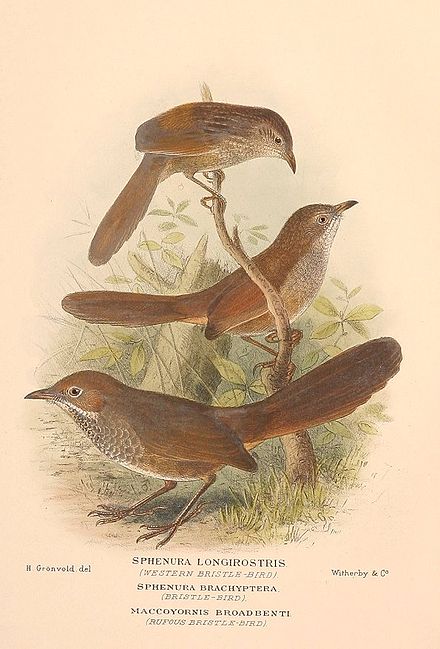Bristlebird
The bristlebirds are a family of passerine birds, Dasyornithidae. There are three species in one genus, Dasyornis. The family is endemic to the south-east coast and south-west corner of Australia.[1] The genus Dasyornis was sometimes placed in the Acanthizidae or, as a subfamily, Dasyornithinae, along with the Acanthizinae and Pardalotinae, within an expanded Pardalotidae, before being elevated to full family level by Christidis & Boles (2008).[2][3]
Taxa accepted or described by Schodde & Mason (1999)[4] include, with their estimated conservation status:
Once placed within various Northern Hemisphere lineages (such as Old World warblers or Old World flycatchers), the Dasyornithidae's closest relatives are now known to be Australian endemics such as the pardalotes and honeyeaters. Although their exact position within the Australasian basal lineages of passerines is not fully resolved, Marki et al.’s 2017[5] study, the first to sample and sequence molecular data for all three species of bristlebirds, placed them within the ecologically diverse infra-order Meliphagides (formerly known as Meliphagoidea). This lineage consists of five families: Maluridae (fairywrens and allies), Acanthizidae (thornbills and gerygones), Meliphagidae (honeyeaters), Pardalotidae (pardalotes) and Dasyornithidae (bristlebirds).[6] While other families within this grouping are highly speciose e.g. the Meliphagidae (honeyeaters) - 187 species, Dasyornis broadbenti, D. brachypterus and D. longirostris are only three known species of bristlebirds. Marki et al. found strong support for D. broadbenti as sister lineage to D. brachypterus and D. longirostris, having diverged from its relatives in the mid-Miocene ca.13 Mya and that D. brachypterus and D. longirostrisdiverged in the early Pliocene, ca. 5 Mya. They infer from this that genetic divergences within the family may be greater than their similar morphologies might suggest and urge denser sampling to explore the possibility of overlooked cryptic species.
Bristlebirds are long-tailed, sedentary, ground-frequenting birds. They vary in length from about 17 cm to 27 cm, with the Eastern bristlebird the smallest, and the Rufous bristlebird the largest, species. Their colouring is mainly grey with various shades of brown, ranging from olive-brown through chestnut and rufous, on the plumage of the upperparts. The grey plumage of the underparts or the mantle is marked by pale dappling or scalloping.[7] The common name of the family is derived from the presence of prominent rictal bristles[2]- three stiff, hair-like feathers curving downwards on either side of the gape. This feature distinguishes them from the scrub-birds, to which they are similar in appearance although not closely related. The bristles, which are conspicuous in many birds that like the bristlebirds forage for insects in dark locations, may serve a tactile function in locating or manipulating prey.
